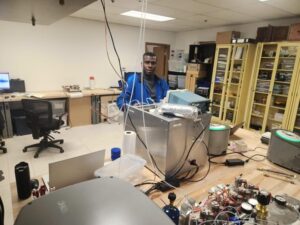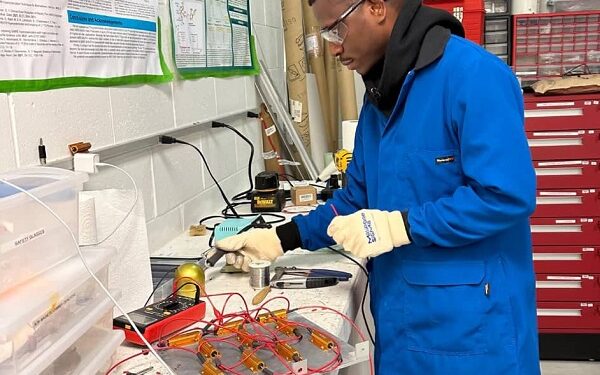ACCRA, Oct 22 (The African Portal) – A team of researchers including Ghanaian scientist at Wayne State University, Joseph Nana Gyesi has developed a revolutionary technology that could make advanced magnetic resonance imaging (MRI) more accessible to hospitals across Africa.
The innovation known as continuous delivery of cryogen-free xenon system enables scientist to produce and maintain hyperpolarised xenon-129(¹²⁹Xe) gas without the need for expensive liquid nitrogen cooling.
The hyperpolarized xenon-129 (¹²⁹Xe) is a special gas that can enhance MRI signals by over ten thousand times, allowing doctors to observe organs such as the lungs in real time. Traditionally, producing and using this gas has required complex and expensive cryogenic systems, but the new technology can do it without liquid nitrogen.
Lasers to Lungs
In 2022, the U.S. Food and Drug Administration (FDA) approved hyperpolarized xenon-129 for lung imaging, a milestone that allowed doctors to visualize airflow, oxygen exchange, and detect early signs of diseases such as asthma and pulmonary fibrosis.
However, the technology’s potential has remained largely untapped in the developing continents such as Africa. Traditional production of polarized xenon relies on a delicate process known as spin-exchange optical pumping, which uses laser-excited rubidium vapor and cryogenic cooling to align the xenon atoms.
The cryogen-free system also offers environmental advantages. For instance, it consumes less energy and avoids the challenges of cryogen storage in tropical climates because it does not require nitrogen.
Cryogenic Barrier
When asked what inspired his recent research, Gyesi said “We wanted to make powerful imaging technology more accessible, especially to parts of the world where cost and infrastructure often stand in the way”.
He explained that the cryogen-free continuous delivery system designed by the team can maintain xenon’s polarization for up to 15 minutes at room temperature. The result is a steady-flow gas stream that can be fed directly into MRI scanners or analytical instruments.
“We have shown that it’s possible to continuously deliver hyperpolarized xenon gas at room temperature, which means hospitals without cryogenic infrastructure can now consider using this powerful imaging tool” he further explained.

Gyesi added that producing polarised xenon typically requires freezing the gas with liquid nitrogen, stressing “that process isn’t just expensive — it’s not practical for hospitals or laboratories in developing countries, including Ghana”.
He stated that the team turned what used to be a stop-and-start batch process into a smooth, continuous one, adding that even after travelling several meters through tubing, over 16 per cent of the xenon’s magnetization was preserved — that’s more than enough for clinical and laboratory use.
According to him, the system’s simplicity and portability could transform how medical imaging is conducted in low-resource environments.
“Many hospitals in Ghana already have MRI machines, but they are often limited by the high cost of imported contrast agents. This system offers a cost-effective alternative that could expand what those machines can do” he said.
New Frontier
The implications for African healthcare are significant. By eliminating the need for liquid nitrogen and reducing operational costs, the new system opens the door for regional hospitals, universities, and research institutions to conduct advanced imaging studies that were previously out of reach.
The Ghanaian Scientist said, “it is about making high-tech science possible in low-resource settings. This could change how we diagnose and study lung diseases, and even how we monitor drug interactions or material absorption in laboratories”.
Beyond healthcare, he pointed out that the hyperpolarized xenon can act as a molecular sensor, detecting how drugs bind to their targets or how gases are absorbed in materials — capabilities that could benefit Ghanaian researchers in environmental, pharmaceutical, and energy sectors.
Collaboration
Gyesi emphasized that the project’s success was rooted in global collaboration. “What we have achieved at Wayne State shows what is possible when researchers across countries work together. Ghanaian scientists have the talent and creativity, what is needed now is the infrastructure and investment to bring these technologies home” he said.
He expressed hope that the system would adopt in teaching hospitals and research centres in Ghana to enhance healthcare delivery while inspiring future scientists to push the boundaries of innovation.






